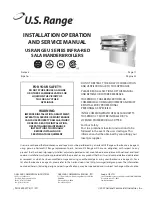
24
Part No. 5106463
Pre-Installation Requirements
The automatic air vent automatically expels any air-
released from the water and thereby keeps the boiler
fully charged.
Filling and Make-up Loop
A connection must be incorporated into the central
heating system to facilitate filling. There must be no
direct connection to the mains water supply, even
through a non-return valve, without the approval of the
Local Water Authority. The filling point must be at low
level, water loss must be replaced. The connection
should be made in the central heating return as close
to the boiler as possible.
Permissible methods of filling
Direct method - A detachable flexible hose is connected
to a stop valve fitted to an outlet on the service main.
The other end of the hose is connected to a second
stop valve and a double check valve. The double check
valve is fitted to an inlet connection on the central
heating return pipe. The hose should be disconnected
after filling. Where the mains pressure is excessive a
pressure reducing valve shall be used to make filling
easier.
Note: On the Flowsure and F, this method is
recommended, and the associated components are
supplied with the boiler. A pressure reducing valve is
not required as the stop valve incorporates a flow
restrictor. (restricted to 10 l/m).
Booster pump method - The system may be filled
through a self contained unit comprising a cistern,
pressure booster pump and if necessary, an automatic
pressure-reducing valve or flow restrictor. The pressure
booster pump must be capable of pressurising the
system to a minimum of 1.0 bar (14 p.s.i.) measured at
the appliance. The cistern should be supplied through
a temporary connection from a service pipe or cold
water distributing pipe. The unit may remain
permanently connected to the heating system to
provide limited water make-up.
Provision should be made for replacing water loss
from the system by re-pressurisation of the system
Domestic Hot Water
Statesman System
The domestic hot water cylinder (where fitted) must be
of the indirect coil type and suitable for working at a
gauge pressure of 0.35 bar above the safety-valve
setting, i.e. 3.65 bar.
Statesman Flowsure and F
The final 600 mm of the mains cold water connection
to the boiler should be made in copper tubing to BS
2871 Pt 1, which is recommended for water carrying
pipework and must be used for pipework carrying
potable water. All capillary joints in the D.H.W. pipework
must be joined with a lead free solder.
The boiler is suitable for mains cold water supply having
a maximum pressure of up to 10 bar (145 lb/in²). A
pressure reducing valve must be fitted if the mains
pressure exceeds 10 bar.
If there are long pipe runs to the taps or shower. It is
suggested that they be insulated to prevent the rapid
cooling of residual hot water in the pipes after the tap
has been turned off.
Taps and Valves - Hot and cold taps and mixing valves
used with these boilers must be suitable for operating
at a mains pressure of up to 10 bar (145 lb/in²).
Showers (Fixed head type) - No anti-syphonage
arrangements are necessary. Thermostatically
controlled shower valves will give extra comfort and
guard against flow of water at too a high a temperature.
Showers (Loose or flexible head type) - A loose head
shower hose must be fixed so that the head cannot fall
closer than 25 mm (1 in) above the top edge of the
bath to prevent its immersion in bath water. Alternatively
the shower must incorporate or be fitted with an anti-
syphonage device at the point of the flexible hose
connections.
Bidets - The supply of hot and cold mains water direct
to a bidet is permitted (subject to local Water Company
requirements) provided that the bidet is of the over-rim
flushing type. The outlet(s) should be shrouded and
unable to have any temporary hand held spray attached.
No anti-syphonage arrangements are necessary.
Use in Hard Water Areas
If the area of installation is recognised as a hard water
area, (above 200 p.p.m.) it is essential that a suitable
water treatment device of an electronic, magnetic or
galvanic type be installed in the mains water supply.
To assess water hardness, immerse the test strip
supplied, for about one second in a water sample (NOT
IN RUNNING WATER) so as to moisten all the zones.
Inspect the strip after 1-2 minutes, check the zones, if
two or more zones have changed colour the hardness
of the water is above 200 p.p.m. and a water treatment
device will be required.
















































